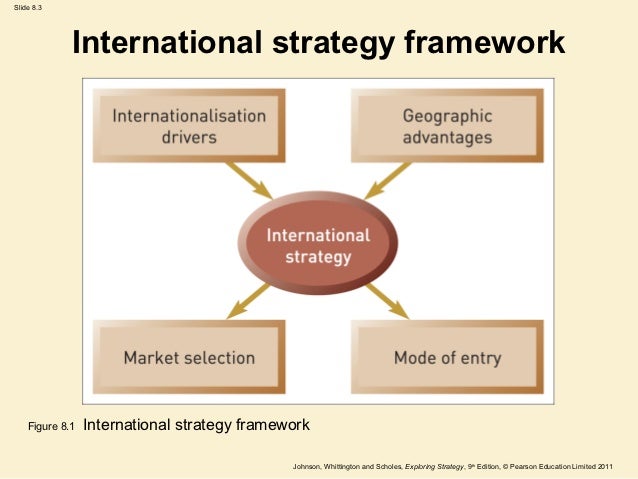George Yip's Globalization Model 639 Words 3 Pages YIP’S GLOBALIZATION MODEL We have followed George Yip’s famous globalization model (1992) to analyse the forces behind attractiveness of globalization for telecom firms in India and more specifically Bharti Airtel.
George Yip (born 24 September 1947)[1] is a research specialist in global strategy and marketing and Professor of Management and Co-Director, Centre on China Innovation, at China Europe International Business School, based in both London and Shanghai. He is also a Marketing and Strategy Professor at Imperial College Business School. His book, Total Global Strategy: Managing for Worldwide Competitive Advantage (Prentice Hall, 1992; 1995) was selected as one of the 30 best business books of 1992 by Soundview Executive Book Summaries. His latest book is Managing Global Customers: An Integrated Approach, with Audrey Bink, Oxford University Press, September 2007. His next book is Strategic Transformation: Changing While Winning, with Manuel Hensmans and Gerry Johnson, Palgrave Macmillan, January 2013. He serves on the editorial advisory board of MIT Sloan Management Review and other journals.
He grew up in Hong Kong, Burma, and England and was educated at Dover College, and Magdalene College, Cambridge University in UK. An MBA from Harvard Business School, Yip is also a ‘Doctor of Business Administration’ in Business Policy from Harvard Business School where he was supervised by Prof. Michael E. Porter.
He retired in 2011 as Dean of Rotterdam School of Management, Erasmus University. He was previously Professor of Strategic and International Management and Associate Dean at London Business School, and the Chair of Marketing and Strategy at Cambridge University, and has also held faculty positions at Harvard Business School and UCLA. He has won two “best teaching” awards at UCLA and “best research” awards from Business Horizons (2000) and Journal of International Marketing (2000). The Times Higher Education Supplement ranked him among the 12 most successful academic consultants in the UK in any discipline (2006).
George Yip’s business experience spans from marketing and product management to consulting and innovation. He began his business career working in marketing and product management with Unilever. He also worked in account management for Lintas. He was the Senior Manager of Price Waterhouse's strategic management consulting services in the Eastern United States, and also a Senior Associate with The MAC Group in Cambridge, Massachusetts. Before becoming dean of Rotterdam School of Management, Erasmus University, he was Director of Research & Innovation at Capgemini Consulting.
His current research interests are in strategic transformation, innovation, and global customers.
Personal life[edit]
Yip is married to linguist Moira Yip with whom he has two grown children.
Career[edit]
- Professor of Management and Co- Director, Centre on China Innovation, China Europe International Business School (2011 - )
- Dean, Rotterdam School of Management, Erasmus University (2008–2011)
- Director of Research & Innovation, Capgemini Consulting (2006–2008)
- London Business School, (2001–2006), Associate Dean (2001–2003)
- Chair of Marketing and Strategy, Cambridge University (1998–2000)
- Senior Manager, Strategic Management Consulting, Price Waterhouse, Boston, United States (1986–1987)
- Senior Associate, The MAC Group, Cambridge, Massachusetts (1983–1986)
- Assistant Professor, Harvard Business School, (1980–1983)
- Business Manager, Data Resources inc (1976–1978)
- Account Supervisor and Product Manager, Unilever – Lintas and Birds Eye Foods (1970–1974)
Books and articles[edit]
- China's Next Strategic Advantage: From Imitation to Innovation, 2016
- Total Global Strategy: Managing for Worldwide Competitive Advantage 1992; 1995 - ISBN0-13-124488-4
- Managing Global Customers, E2007
- Total Global Strategy II, 2003
- Asian Advantage: Key Strategies for Winning in the Asia-Pacific Region, 2000 - ISBN0-201-33978-1
- Strategies for Central and Eastern Europe, 2000
- Barriers to Entry: A Corporate Strategy Perspective, 1983
- Articles in several leading publications including California Management Review, Harvard Business Review, Sloan Management Review
See also[edit]
References[edit]
- ^YIP, Prof. George Stephen, Who's Who 2014, A & C Black, 2014; online edn, Oxford University Press, 2014

1. http://www.rsm.nl/portal/page/portal/RSM2/content_pages/News%20and%20events%20RSM/RSM%20News/FEM%20Business%20George%20Yip%20UK.pdf[permanent dead link]

External links[edit]
•Advanced Institute of Management Research profile on George Yip
•Management Issues interview with George Yip
•Academy of International Business profile on George Yip
•Curriculum vitae[permanent dead link]
George Yip Model Of Drivers Of Internationalisation
Retrieved from 'https://en.wikipedia.org/w/index.php?title=George_Yip&oldid=842502302'
That is why it is important to understand how industry globalization drivers affect the threat of entry and rivalry among existing competitors.MARKET GLOBALIZATION DRIVERS Market globalization drivers-common customer needs, global customers, global channels, transferable marketing, and lead countries-depend on the nature of customer behavior and the structure of channels of distribution. These drivers affect the use of all five global strategy levers. As illustrated in Exhibit 2-1, different industries have different levels of market globalization drivers. These comparative rankings are approximate only and will also change with time.Common Customer Needs Common customer needs represent the extent to which customers in different countries have the same needs in the product or service category (or the group of products and services) that defines an industry. Many factors affect whether customer needs are similar in different countries. These factors include whether differences in economic development, climate, physical environment, and culture affect needs in the particular product or service category as well as whether the countries are at the same stage of the product life cycle.[?] Common customer needs particularly affect the opportunity to use the global strategy levers of global market participation, global products and services, and global competitive moves. Common needs make it easier to